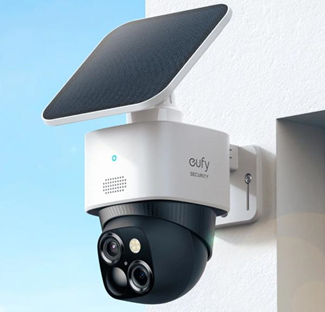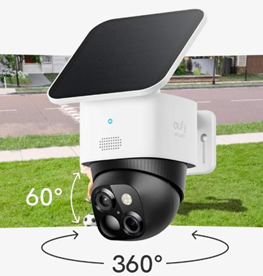Choosing the right outdoor security cameras involve weighing options like power, installation, maintenance, cost, security, and privacy. Battery-Powered and wired outdoor cameras each offer unique advantages and drawbacks that can significantly impact their performance and suitability for different homes. This comprehensive guide will delve into each aspect, helping you make an informed decision suitable for your specific needs. We’ll explore the characteristics, setup simplicity, and long-term value, along with addressing security concerns for both options. Whether prioritizing flexibility, reliability, or budget-friendliness, understanding these factors will empower you to choose the best surveillance solution for keeping your home safe and secure.

Power
Characteristics of Battery-Powered Supply
Battery-powered outdoor cameras offer unmatched flexibility and convenience. They eliminate the need for complex wiring, allowing easy repositioning as surveillance needs change. These cameras rely on rechargeable batteries, minimizing dependency on power outlets. However, battery life can vary significantly based on camera usage and settings. Regular charging is essential, typically every few weeks to months, based on activity levels and battery capacity. Some models support solar panels, extending battery life considerably and reducing manual charging frequency. Despite their ease, battery-powered cameras might fail during prolonged power outages since they rely solely on stored energy. Ideal for temporary setups or areas with no power access, battery-powered cameras prioritize mobility but require users to manage power levels actively.
Characteristics of Wired Power Supply
Wired outdoor cameras provide a more stable and consistent power source, often favored for their reliability in continuous operation. These cameras connect directly to your home’s electrical system or a central power unit, eliminating concerns about battery life or frequent recharging. Wired systems support 24/7 surveillance without interruption, ensuring that the security feed remains constant even during extended absences. However, these cameras necessitate proximity to power outlets, limiting placement options. Electrical wiring complexity can also elevate initial setup costs and require professional installation, especially if running cables through walls or underground. Wired cameras are ideal for permanent setups requiring thorough, uninterrupted monitoring without the hassle of managing battery recharges.
Installation
Ease of Setup for Battery-Powered Carema
Battery-powered cameras shine in installation simplicity, appealing to DIY enthusiasts and renters. Without intricate wiring needs, these units can be mounted almost anywhere, offering superior flexibility in choosing and changing camera locations. Installation often involves attaching the camera to a mount and configuring it through a mobile app, a process conducive to quick setups and adjustments. Their adaptability makes them perfect for renters or those seeking temporary security solutions. Since most models are wire-free, they blend seamlessly into the surroundings, minimizing visual interruptions to your home’s aesthetics. Despite these advantages, users must regularly check battery status, an ongoing task that might deter those seeking set-and-forget solutions.
Challenges of Wired Camera Installation
Wired cameras, while providing robust performance, engage users with more complex installation processes. Often necessitating professional help, these setups involve routing cables through walls, ceilings, or external conduits to connect to the power source and network. This process can be time-consuming and potentially invasive, carrying higher installation costs and demanding clear planning for optimal camera placement. Once set, wired cameras offer exceptional stability, yet relocation or system upgrades can be cumbersome due to their fixed wiring. For homeowners committed to long-term security solutions, investing in professional installation ensures reliability and maximizes coverage, albeit with upfront effort and expense.

Maintenance & Cost
Battery Life & Ongoing Costs
Maintenance for battery-powered cameras revolves primarily around managing battery life, which varies significantly by model and usage patterns. Frequent activity recording can deplete batteries faster, necessitating regular recharges or replacements. Some users might opt for backup batteries to minimize downtime. Certain models offer solar charging capabilities, reducing manual maintenance but increasing initial costs. Over time, investing in backup batteries or advanced charging solutions adds to the total cost of ownership. While initial setup costs might be low, but consistent vigilance in maintaining battery levels to ensure uninterrupted surveillance can accumulate expenses over time, especially for extensive setups covering multiple areas.
Wired Camera Maintenance & Power Bills
Wired cameras typically require less frequent maintenance. However, they involve continuous power consumption, potentially impacting electricity bills. The initial setup, although costly due to professional installation, reduces the need for repeated intervention unless relocation or expansion is desired. Wired systems benefit from stable operation, usually free from common battery issues. Yet, infrequent electrical disruptions or damage to wiring can demand unexpected repairs, potentially mounting supplementary expenses. Despite higher initial costs, the minimal ongoing maintenance and constant power supply often balance operational expenses, making wired systems economically favorable for continuous, long-term surveillance needs.
Long-Term Value Comparison
When assessing value, considerations extend beyond immediate costs to longevity and efficiency. Battery-powered cameras appeal with lower upfront investments and installation simplicity. However, recurring battery replacements and potential technological upgrades add to the cumulative expense. Wired cameras command higher initial costs but often boast longer lifespans due to durable components and stable power supplies. They generally require fewer technological updates, maintaining relevance longer with proper maintenance. Weighing lifetime expenses, wired systems can emerge more cost-effective for static home environments desiring constant monitoring. Battery-powered cameras win where flexibility and incremental investment align better with user preferences or mobile dwelling considerations.
Conclusion
Selecting between battery-powered and wired outdoor cameras hinges on individual preferences for flexibility, reliability, and budget. Battery-powered cameras win in quick installation and adaptability, ideal for renters or those seeking temporary security solutions. Yet, potential ongoing maintenance due to battery recharges highlights a recurrent user responsibility. Wired systems promise steadfast performance and long-term savings on operational costs. They’re best suited for permanent installations demanding vigorous, non-stop monitoring. By evaluating personal home security priorities and combing through associated costs and advantages, homeowners can pinpoint which solution best meets their protection needs while ensuring consistent safety vigilance.
